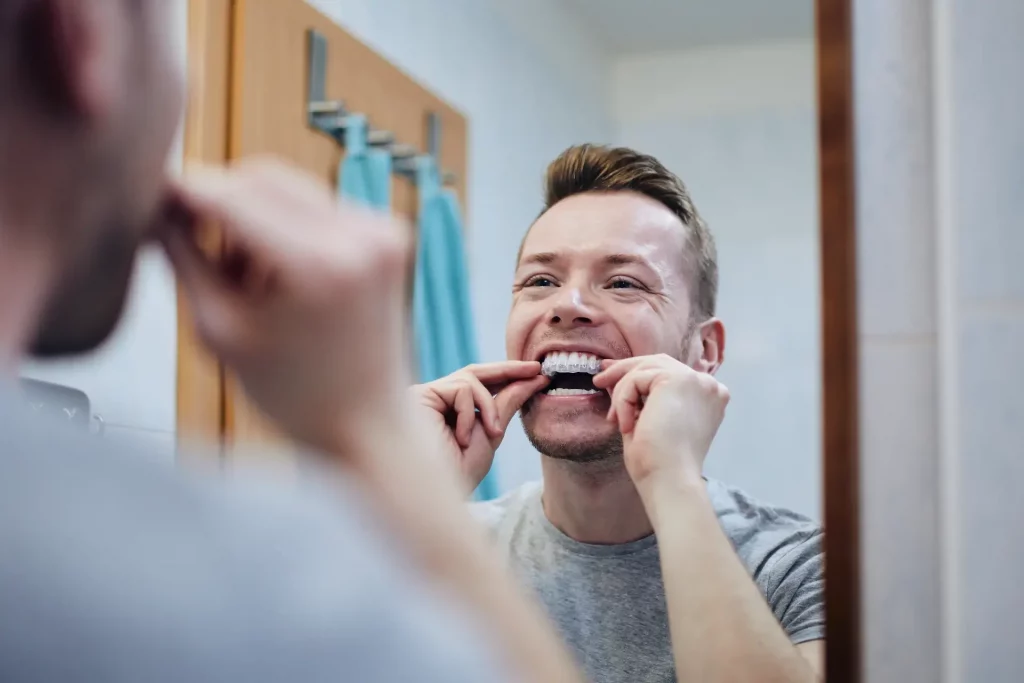
You want straight, perfectly aligned teeth. However, the thought of wearing braces is just too much, or you’re unsure of what to expect when it comes to wearing Invisalign clear aligners. But with Invisalign clear aligners, you can receive orthodontic care faster and with less hassle than traditional braces. Learn everything you need to know before your complimentary consultation and what to expect during the initial consultation process from your Allen dentist.
Here’s a quick overview of why Invisalign is so popular when it comes to why so many patients in the Allen and Fairview areas choose Invisalign. For more information about Invisalign, click on this link.
The Invisalign system is designed to fit into your busy life with minimal lifestyle changes. It’s easy to take out aligners to eat, drink, brush your teeth, and floss, and you won’t need to change your diet. If you enjoy contact sports or other activities that require a mouth guard, you can continue with these activities, just simply remove your plastic aligners before participating in these activities and put them back on after.
The Invisalign system is the best option for straighter teeth and practicing good oral hygiene because it allows you to remove your aligners and clean them separately at least twice daily while brushing your teeth. The aligners are easy to clean with a simple toothbrush and water. You’ll also be able to brush and floss your teeth without brackets and wires getting in the way, which can help you prevent tooth decay that often occurs with traditional metal braces.

At Sloan Creek Dental, we are committed to helping you choose the right treatment for your smile. That’s why we offer an initial complimentary Invisalign consultation, during which we will assess your situation and make sure that Invisalign is the right choice for you.
If you decide to move forward with Invisalign, your dentist will need to capture impressions of your teeth. This can be done using an iTero Scanner to create a digital 3D impression (3D scan), or through the traditional method which involves a bite registration to mold aligner trays. Digital scanning is typically faster, as the dentist simply scans your teeth to generate a 3D model. However, if the conventional route is chosen, your dentist will gently insert impression material into your mouth and remove it, creating a mold that serves as the basis for your aligners. The material is soft and comfortable, often likened to the texture of putty or clay.
The process takes no more than five minutes for each dental arch (upper or lower). Once completed, your impressions will be sent to a lab for aligner fabrication, a process that may take two to three weeks.

Every six weeks, we’ll see you for a quick checkup to ensure everything goes according to the treatment plan. If there are any issues with your teeth, we can adjust your aligners as needed and ensure they fit properly. If they are, we’ll send you home with new aligner trays to keep everything on track. We’ll also take some time to review your progress since our last visit and answer any questions you have about the process or your treatment plan.
Though Invisalign is an excellent solution for many dental issues, it may not be suitable for everyone as Invisalign is not a substitute for traditional braces. If you have complex orthodontic issues, Invisalign may not be the effective treatment option. For example, if your teeth are crowded or you have a deep bite, Invisalign cannot correct these issues. Similarly, if your teeth are out of alignment because of an open bite (when the upper and lower teeth do not meet evenly), Invisalign cannot fix this problem either. During your initial consultation, your dentist will let you know whether you’re a good candidate for this treatment option.
The cost of Invisalign varies from patient to patient as the duration of treatment, and other dental conditions may affect the price. Some people may need to wear their aligners for longer than others, and other dental treatments may be involved prior to putting Invisalign aligners on. The average cost is between $3,500 and $8,000. During your consultation, your dentist will give you a breakdown of what’s expected while discussing your treatment plan.
Many people who are new to Invisalign are initially surprised by how much the treatment cost compared to traditional braces. The reason is that Invisalign has a different treatment regimen than traditional braces and is more comfortable than many other orthodontic treatments. It also requires the aligners to be created in a lab using unique plastic materials due to the advanced designs.
Many dental insurance plans treat Invisalign the same way they treat braces. Your insurance may pay for a certain percentage of your Invisalign treatment, or it may pay for a certain dollar amount. Depending on your insurance coverage, some insurance companies put a limit on the amount of orthodontic treatment they will cover in one person’s lifetime.
When you first put on your custom aligners, there will be some pressure and discomfort. The discomfort typically lessens in a couple of days after each new set of Invisalign trays. This is normal and a sign that your teeth are moving as they should, shifting into their final position that Dr. Feng carefully planned.

We firmly believe that the internet should be available and accessible to anyone, and are committed to providing a website that is accessible to the widest possible audience, regardless of circumstance and ability.
To fulfill this, we aim to adhere as strictly as possible to the World Wide Web Consortium’s (W3C) Web Content Accessibility Guidelines 2.1 (WCAG 2.1) at the AA level. These guidelines explain how to make web content accessible to people with a wide array of disabilities. Complying with those guidelines helps us ensure that the website is accessible to all people: blind people, people with motor impairments, visual impairment, cognitive disabilities, and more.
This website utilizes various technologies that are meant to make it as accessible as possible at all times. We utilize an accessibility interface that allows persons with specific disabilities to adjust the website’s UI (user interface) and design it to their personal needs.
Additionally, the website utilizes an AI-based application that runs in the background and optimizes its accessibility level constantly. This application remediates the website’s HTML, adapts Its functionality and behavior for screen-readers used by the blind users, and for keyboard functions used by individuals with motor impairments.
If you’ve found a malfunction or have ideas for improvement, we’ll be happy to hear from you. You can reach out to the website’s operators by using the following email
Our website implements the ARIA attributes (Accessible Rich Internet Applications) technique, alongside various different behavioral changes, to ensure blind users visiting with screen-readers are able to read, comprehend, and enjoy the website’s functions. As soon as a user with a screen-reader enters your site, they immediately receive a prompt to enter the Screen-Reader Profile so they can browse and operate your site effectively. Here’s how our website covers some of the most important screen-reader requirements, alongside console screenshots of code examples:
Screen-reader optimization: we run a background process that learns the website’s components from top to bottom, to ensure ongoing compliance even when updating the website. In this process, we provide screen-readers with meaningful data using the ARIA set of attributes. For example, we provide accurate form labels; descriptions for actionable icons (social media icons, search icons, cart icons, etc.); validation guidance for form inputs; element roles such as buttons, menus, modal dialogues (popups), and others. Additionally, the background process scans all of the website’s images and provides an accurate and meaningful image-object-recognition-based description as an ALT (alternate text) tag for images that are not described. It will also extract texts that are embedded within the image, using an OCR (optical character recognition) technology. To turn on screen-reader adjustments at any time, users need only to press the Alt+1 keyboard combination. Screen-reader users also get automatic announcements to turn the Screen-reader mode on as soon as they enter the website.
These adjustments are compatible with all popular screen readers, including JAWS and NVDA.
Keyboard navigation optimization: The background process also adjusts the website’s HTML, and adds various behaviors using JavaScript code to make the website operable by the keyboard. This includes the ability to navigate the website using the Tab and Shift+Tab keys, operate dropdowns with the arrow keys, close them with Esc, trigger buttons and links using the Enter key, navigate between radio and checkbox elements using the arrow keys, and fill them in with the Spacebar or Enter key.Additionally, keyboard users will find quick-navigation and content-skip menus, available at any time by clicking Alt+1, or as the first elements of the site while navigating with the keyboard. The background process also handles triggered popups by moving the keyboard focus towards them as soon as they appear, and not allow the focus drift outside of it.
Users can also use shortcuts such as “M” (menus), “H” (headings), “F” (forms), “B” (buttons), and “G” (graphics) to jump to specific elements.
We aim to support the widest array of browsers and assistive technologies as possible, so our users can choose the best fitting tools for them, with as few limitations as possible. Therefore, we have worked very hard to be able to support all major systems that comprise over 95% of the user market share including Google Chrome, Mozilla Firefox, Apple Safari, Opera and Microsoft Edge, JAWS and NVDA (screen readers), both for Windows and for MAC users.
Despite our very best efforts to allow anybody to adjust the website to their needs, there may still be pages or sections that are not fully accessible, are in the process of becoming accessible, or are lacking an adequate technological solution to make them accessible. Still, we are continually improving our accessibility, adding, updating and improving its options and features, and developing and adopting new technologies. All this is meant to reach the optimal level of accessibility, following technological advancements. For any assistance, please reach out to